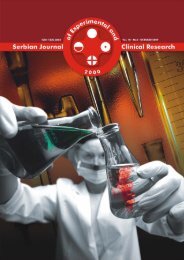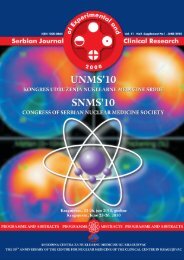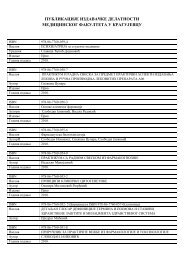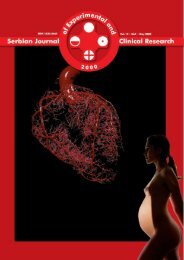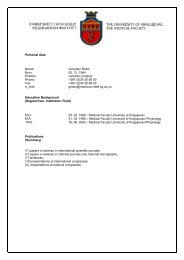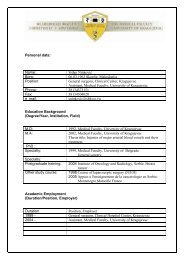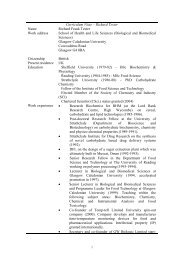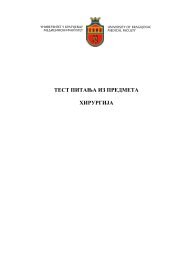neurotoxicity and mechanisms of induced hyperexcitability
neurotoxicity and mechanisms of induced hyperexcitability
neurotoxicity and mechanisms of induced hyperexcitability
You also want an ePaper? Increase the reach of your titles
YUMPU automatically turns print PDFs into web optimized ePapers that Google loves.
B) Spontaneous modelsGoto Kakizaki RatThe Goto Kakizaki (GK) rat is skinny, diabetic rat developedin Japan in 1975 from Wistar species (6). Bothinsulin resistance <strong>and</strong> impaired insulin secretion are presentin this model (32). GK rats have a decreased numbers<strong>of</strong> beta cells at birth, which is probably the consequence<strong>of</strong> their apoptosis during embryonic development (16-18day). However, GK rats are still normoglycemic <strong>and</strong> withoutmarked changes in islet morphology at birth (33). Thecharacteristics <strong>of</strong> diabetes type 2 in this model are mildhyperglycemia (9 mmol/l) in the fourth week <strong>and</strong> the increase<strong>of</strong> basal insulin secretion <strong>and</strong> insulin resistance followedby a decrease in glucose tolerance (34). GK rats areresistant to food intake restrictions (35).Starting from the 8 th week, insulin islets show signs <strong>of</strong> fibrosiswith a marked elevation <strong>of</strong> hyperglycemia (36). In addition,the expression <strong>of</strong> CD38 <strong>and</strong> GLUT2 proteins is reducedin GK islets (37-38). Microscopically, numerous macrophages(major histocompatibility complex class II + <strong>and</strong> CD68 + ) <strong>and</strong>granulocytes were found in <strong>and</strong> around pancreatic islets (39).Elevated islet IL-1β activity in GK rat promotes cytokine <strong>and</strong>chemokine expression, leading to the recruitment <strong>of</strong> innateimmune cells (40). Treatment <strong>of</strong> GK rats with IL-1 receptorantagonists decreases hyperglycemia, reduces the proinsulin/insulin ratio <strong>and</strong> improves insulin sensitivity (40).The most important factor for the disorder <strong>of</strong> insulin secretionis the dysfunction <strong>of</strong> glucose metabolism connectedwith a deficiency <strong>of</strong> enzymes that control oxidative glycolysis(6). The GK rat develops some features that can be comparedwith the complications <strong>of</strong> diabetes seen in humans (1).Zucker Fatty <strong>and</strong> Zucker Fatty Diabetic RatThe Zucker Fatty (ZF) rat has a defect <strong>of</strong> a gene thatcodes for leptin receptors (fa/fa), resulting in the development<strong>of</strong> obesity <strong>and</strong> hypertension with associated renal<strong>and</strong> cardiovascular disease (6). The Zucker Fatty DiabeticRat (ZDF) has the identical genetic mutation <strong>and</strong>, additionally,a mutation which leads to the spontaneous development<strong>of</strong> hyperglycemia in males during the 7 th -10 thweek (41). The females become hyperglycemic only afterhigh-fat diet, <strong>and</strong> it is supposed that this additional mutationis expressed in beta cells (42).Leptin suppresses insulin secretion <strong>and</strong> controls foodintake. The fa/fa mutation <strong>of</strong> the leptin receptor results ininsulin resistance with severe glucose intolerance (6). ZF<strong>and</strong> ZDF rats are hyperphagic due to the reduction in leptinsignalling that results in obesity (6). These animals, inadulthood, become extremely dislipemic with increasedconcentration <strong>of</strong> free fatty acids, cholesterol, <strong>and</strong> triglyceridesin plasma with a consequent development <strong>of</strong> diabetesmellitus complications (cardiovascular, renal, <strong>and</strong> peripheralneuropathy) (6, 43-44).Pancreatic islets in adults show increased beta cell activity,with marked characteristics <strong>of</strong> a prediabetic state (6).After the onset <strong>of</strong> diabetes, pancreatic islets become irregularas a result <strong>of</strong> hyperplasia, hypertrophy <strong>and</strong> infiltration<strong>of</strong> inflammatory cells (45). An almost complete absence <strong>of</strong>beta cells was detected by the 14 th week <strong>of</strong> age (45).Reduced expression <strong>of</strong> mGDP <strong>and</strong> pyruvate carboxylaseactivity was noticed in this model (46).Otsuka Long Evans Tokushima Fatty RatThe Otsuka Long Evans Tokushima Fatty Rat (OLETF)is derived by inbreeding from the glucose-intolerant Long-Evans colony <strong>of</strong> rats (47). These animals develop hyperglycemiaslowly, by 40 weeks <strong>of</strong> age, with greater incidence inmales than in females (1). Adult animals are mildly obese<strong>and</strong> hyperglycemic, with increased appetite <strong>and</strong> renalglomerulosclerosis. These changes are the result <strong>of</strong> a deletion<strong>of</strong> the gene for cholecystokinin 1 receptors. Diet <strong>and</strong>exercise prevent type 2 diabetes in this model (48).Histopathologic changes inside the islets during the 8 th -10 th week show an infiltration <strong>of</strong> inflammatory cells followedby tissue damage. Beta cell hyperplasia <strong>and</strong> proliferation occurbetween the 20 th <strong>and</strong> 40 th weeks, while atrophy <strong>and</strong> fibrosis<strong>of</strong> the islets start after the 40 th week (47). From the72 nd week, inflammatory cytokines (tumour necrosis factor-(TNF- ), interleukin-1β (IL-1β) <strong>and</strong> interleukin-6 (IL-6)) aredetectable by immunohistochemical method (49).Psammomys obesusThe Psammomys obesus is rat from North America<strong>and</strong> the Middle East. It usually feeds on a low-calorie diet<strong>and</strong> demonstrates the strong effect <strong>of</strong> a high-calorie diet bydeveloping hyperglycemia within 4-7 days (6).Pathogenesis <strong>of</strong> the disorders goes through four typicalstages: normoglycemia <strong>and</strong> normoinsulinemia, normoglycemiawith hyperinsulinemia (indicating insulinresistance), hyperglycemia with hyperinsulinemia, <strong>and</strong> hyperglycemiawith hypoinsulinemia (50). The last stage ischaracterized by marked apoptosis <strong>and</strong> a reduction <strong>of</strong> betacell mass (51). Returning to a low-calorie diet results in therecovery <strong>of</strong> beta cells, indicating that the irreversible loss <strong>of</strong>beta cell mass is a late event (52).TRANSGENIC AND KNOCKOUT MODELSOF DIABETES MELLITUSIn experimental diabetes, numerous transgenic <strong>and</strong>knockout models are being used. These models have beencreated by genetic manipulations using either transgeneinsertion <strong>and</strong>/or targeted gene-deletion approaches.Still, these techniques have some limitations. Somehomozygotes may die in the womb, which makes studiesin adults impossible. Several genes could function differentlyduring embryogenesis <strong>and</strong> in adulthood. Finally,some models’ gene expression is altered in s<strong>of</strong>t tissues, <strong>and</strong>therefore it is impossible to analyze their function in thedesired tissue. Tissue-specific knockout models for diabetes,in which the gene being studied is only knocked out inspecific tissues, were created to address this issue.32



